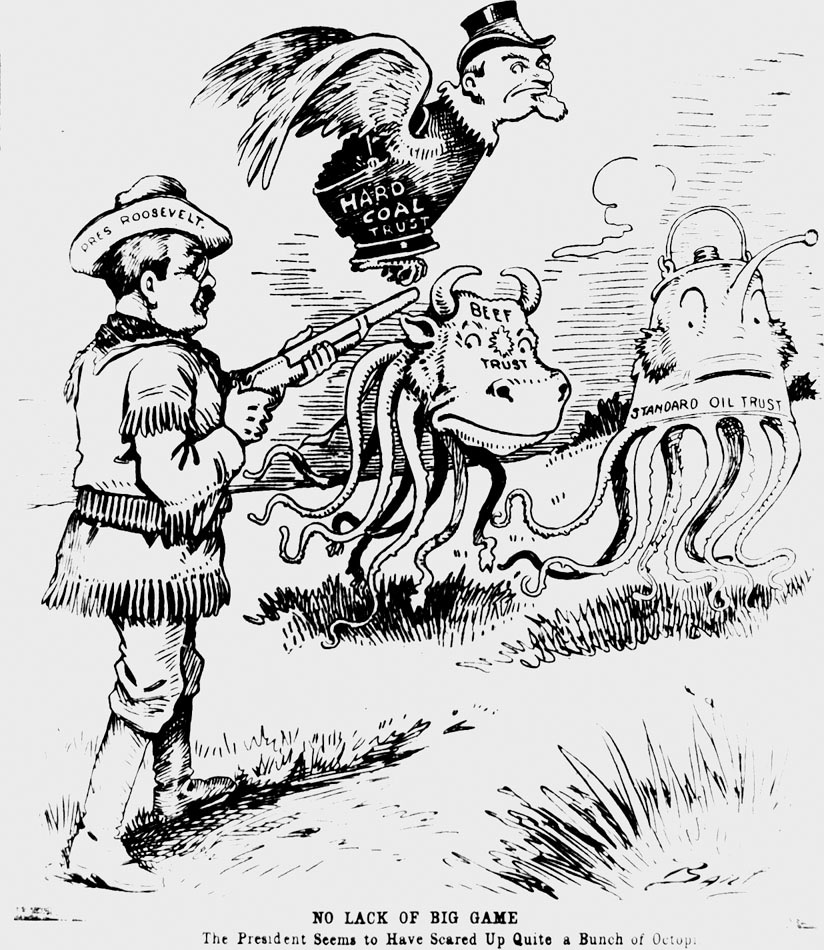1.3 33Oligopoly in Practice

(R) AP Photo/Steven Senne
WHAT YOU WILL LEARN
 The legal constraints of antitrust policy
The legal constraints of antitrust policy
 The factors that limit tacit collusion
The factors that limit tacit collusion
 The cause and effect of product differentiation and price leadership
The cause and effect of product differentiation and price leadership
 The importance of oligopoly in the real world
The importance of oligopoly in the real world
How do oligopolies usually work in practice? The answer depends both on the legal framework that limits what firms can do and on the underlying ability of firms in a given industry to cooperate without formal agreements. In this module we will explore a variety of oligopoly behaviors and how antitrust laws limit oligopolists’ attempts to maximize their profits.
The Legal Framework
To understand oligopoly pricing in practice, we must be familiar with the legal constraints under which oligopolistic firms operate. In the United States, oligopoly first became an issue during the second half of the nineteenth century, when the growth of railroads—
However, although these cartels were legal, their agreements weren’t legally enforceable—members of a cartel couldn’t ask the courts to force a firm that was violating its agreement to reduce its production. And firms often did violate their agreements, for the reason already suggested by our duopoly example in the two previous modules: there is always a temptation for each firm in a cartel to produce more than it is supposed to.
In 1881 clever lawyers at John D. Rockefeller’s Standard Oil Company came up with a solution—
Antitrust policy involves efforts by the government to prevent oligopolistic industries from becoming or behaving like monopolies.
Eventually, there was a public backlash, driven partly by concern about the economic effects of the trust movement and partly by fear that the owners of the trusts were simply becoming too powerful. The result was the Sherman Antitrust Act of 1890, which was intended both to prevent the creation of more monopolies and to break up existing ones. At first this law went largely unenforced. But over the decades that followed, the federal government became increasingly committed to making it difficult for oligopolistic industries either to become monopolies or to behave like them. Such efforts are known to this day as antitrust policy.
One of the most striking early actions of antitrust policy was the breakup of Standard Oil in 1911. Its components formed the nuclei of many of today’s large oil companies—

Among advanced countries, the United States is unique in its long tradition of antitrust policy. Until recently, other advanced countries did not have policies against price-
During the early 1990s, the United States instituted an amnesty program in which a price-
Life has gotten much tougher over the past few years if you want to operate a cartel. So what’s an oligopolist to do?
Tacit Collusion and Price Wars
If real life were as simple as our lysine story, it probably wouldn’t be necessary for the company presidents to meet or do anything that could land them in jail. Both firms would realize that it was in their mutual interest to restrict output to 30 million pounds each and that any short-
Real industries are nowhere near that simple; nonetheless, in most oligopolistic industries, most of the time, the sellers do appear to succeed in keeping prices above their noncooperative level. Tacit collusion, in other words, is the normal state of oligopoly.
Although tacit collusion is common, it rarely allows an industry to push prices all the way up to their monopoly level; collusion is usually far from perfect. Four factors make it hard for an industry to coordinate on high prices.
1. Large NumbersSuppose that there were three instead of two firms in the lysine industry and that each was currently producing only 20 million pounds. In that case any one firm that decided to produce an extra 10 million pounds would gain more in short-
2. Complex Products and Pricing SchemesIn our simplified lysine example the two firms produce only one product. In reality, however, oligopolists often sell thousands or even tens of thousands of different products. In these circumstances, as when there are a large number of firms, keeping track of what other firms are producing and what prices they are charging is difficult. This makes it hard to determine whether a firm is cheating on the tacit agreement.
3. Differences in InterestsIn the lysine example, a tacit agreement for the firms to split the market equally is a natural outcome, probably acceptable to both firms. In other situations, however, firms often differ both in their perceptions about what is fair and in their real interests.
For example, suppose that Ajinomoto was a long-
Alternatively, suppose that ADM’s marginal costs were lower than Ajinomoto’s. Even if they could agree on market shares, they would then disagree about the profit-
4. Bargaining Power of BuyersOften oligopolists sell not to individual consumers but to large buyers—
These difficulties in enforcing tacit collusion have sometimes led companies to defy the law and create illegal cartels. We’ve already examined the cases of the lysine industry and the chocolate industry. An older, classic example was the U.S. electrical equipment conspiracy of the 1950s, which led to the indictment of and jail sentences for some executives. The industry was one in which tacit collusion was especially difficult because of all the reasons just mentioned. There were many firms—
A price war occurs when tacit collusion breaks down and aggressive price competition causes prices to collapse.
Because tacit collusion is often hard to achieve, most oligopolies charge prices that are well below what the same industry would charge if it were controlled by a monopolist—
THE PRICE WARS OF CHRISTMAS
During the last several holiday seasons, the toy aisles of American retailers have been the scene of cutthroat competition: Target priced the latest Elmo doll at 89 cents less than Walmart (for those with a coupon), and $6 less than Toys “R” Us. So extreme is the price-
What is happening? The turmoil can be traced back to trouble in the toy industry itself as well as to changes in toy retailing. Every year for several years, overall toy sales have fallen a few percentage points as children increasingly turn to video games and the Internet. There have also been new entrants into the toy business: Walmart and Target have expanded their numbers of stores and have been aggressive price-
The result is much like a story of tacit collusion sustained by repeated interaction run in reverse: because the overall industry is in a state of decline and there are new entrants, the future payoff from collusion is shrinking. The predictable outcome is a price war.

Since retailers depend on holiday sales for nearly half of their annual sales, the holidays are a time of intense price-
With other retailers feeling as if they have no choice but to follow this pattern, we have the phenomenon known as “creeping Christmas”: the price wars of Christmas arrive earlier each year.
Product Differentiation and Price Leadership
Lysine is lysine: there was no question in anyone’s mind that ADM and Ajinomoto were producing the same good and that consumers would make their decision about which company’s lysine to buy based on the price. In many oligopolies, however, firms produce products that consumers regard as similar but not identical. A $10 difference in the price won’t make many customers switch from a Ford to a Chrysler, or vice versa. Sometimes the differences between products are real, like differences between Froot Loops and Wheaties; sometimes, they exist mainly in the minds of consumers, like differences between brands of vodka (which is supposed to be tasteless). Either way, the effect is to reduce the intensity of competition among the firms: consumers will not all rush to buy whichever product is cheapest.
Product differentiation is an attempt by a firm to convince buyers that its product is different from the products of other firms in the industry.
As you might imagine, oligopolists welcome the extra market power that comes when consumers think that their product is different from that of competitors. So in many oligopolistic industries, firms make considerable efforts to create the perception that their product is different—
A firm that tries to differentiate its product may do so by altering what it actually produces, adding “extras,” or choosing a different design. It may also use advertising and marketing campaigns to create a differentiation in the minds of consumers, even though its product is more or less identical to the products of rivals.
A classic case of how products may be perceived as different even when they are really pretty much the same is over-
Whatever the nature of product differentiation, oligopolists producing differentiated products often reach a tacit understanding not to compete on price. For example, during the years when the great majority of cars sold in the United States were produced by the Big Three auto companies (General Motors, Ford, and Chrysler), there was an unwritten rule that none of the three companies would try to gain market share by making its cars noticeably cheaper than those of the other two.
In price leadership, one firm sets its price first, and other firms then follow.
But then who would decide on the overall price of cars? The answer was normally General Motors: as the biggest of the three, it would announce its prices for the year first; and the other companies would adopt similar prices. This pattern of behavior, in which one company tacitly sets prices for the industry as a whole, is known as price leadership.
Firms that have a tacit understanding not to compete on price often engage in intense nonprice competition, using advertising and other means to try to increase their sales.
Interestingly, firms that have a tacit agreement not to compete on price often engage in vigorous nonprice competition—adding new features to their products, spending large sums on ads that proclaim the inferiority of their rivals’ offerings, and so on.

Perhaps the best way to understand the mix of cooperation and competition in such industries is with a political analogy. During the long Cold War between the United States and the Soviet Union, the two countries engaged in intense rivalry for global influence. They not only provided financial and military aid to their allies; they sometimes supported forces trying to overthrow governments allied with their rival (as the Soviet Union did in Vietnam in the 1960s and early 1970s, and as the United States did in Afghanistan from 1979 until the collapse of the Soviet Union in 1991). They even sent their own soldiers to support allied governments against rebels (as the United States did in Vietnam and the Soviet Union did in Afghanistan). But they did not get into direct military confrontations with each other; open warfare between the two superpowers was regarded by both as too dangerous—
Price wars aren’t as serious as shooting wars, but the principle is the same.
How Important Is Oligopoly?
We have seen that, across industries, oligopoly is far more common than either perfect competition or monopoly. When we try to analyze oligopoly, the economist’s usual way of thinking—
The conclusion of the great majority of economists is yes. For one thing, important parts of the economy are fairly well described by perfect competition. And even though many industries are oligopolistic, in many cases the limits to collusion keep prices relatively close to marginal costs—
It is also true that predictions from supply and demand analysis are often valid for oligopolies. For example, we saw that price controls will produce shortages. Strictly speaking, this conclusion is certain only for perfectly competitive industries. But in the 1970s, when the U.S. government imposed price controls on the definitely oligopolistic oil industry, the result was indeed to produce shortages and lines at the gas pumps.
So how important is it to take account of oligopoly? Most economists adopt a pragmatic approach. As we have seen here, the analysis of oligopoly is far more difficult and messy than that of perfect competition; so in situations where they do not expect the complications associated with oligopoly to be crucial, economists prefer to adopt the working assumption of perfectly competitive markets. They always keep in mind the possibility that oligopoly might be important; they recognize that there are important issues, from antitrust policies to price wars, that make trying to understand oligopolistic behavior crucial.
33
Solutions appear at the back of the book.
Check Your Understanding
1. For each of the following industry practices, explain whether the practice supports the conclusion that there is tacit collusion in this industry.
-
a. For many years the price in the industry has changed infrequently, and all the firms in the industry charge the same price. The largest firm publishes a catalog containing a “suggested” retail price. Changes in price coincide with changes in the catalog.
This is evidence of tacit collusion. Firms in the industry are able to tacitly collude by setting their prices according to the published “suggested” price of the largest firm in the industry. This is a form of price leadership. -
b. There has been considerable variation in the market shares of the firms in the industry over time.
This is not evidence of tacit collusion. Considerable variation in market shares indicates that firms have been competing to capture each other’s business. -
c. Firms in the industry build into their products unnecessary features that make it hard for consumers to switch from one company’s products to another’s.
This is not evidence of tacit collusion. These features make it less likely that consumers will switch products in response to lower prices. So this is a way for firms to avoid any temptation to gain market share by lowering price. This is a form of product differentiation used to avoid direct competition. -
d. Firms meet yearly to discuss their annual sales forecasts.
This is evidence of tacit collusion. In the guise of discussing sales targets, firms can create a cartel by designating quantities to be produced by each firm. -
e. Firms tend to adjust their prices upward at the same times.
This is evidence of tacit collusion. By raising prices together, each firm in the industry is refusing to undercut its rivals by leaving its price unchanged or lowering it. Because it could gain market share by doing so, refusing to do so supports the conclusion that there is tacit collusion.
Multiple-
Question
1. Having which of the following makes it easier for oligopolies to coordinate on raising prices?
| A. |
| B. |
| C. |
| D. |
| E. |
Question
2. Which of the following led to the passage of the first antitrust laws?
I. growth of the railroad industry
II. the emergence of the Standard Oil Company
III. increased competition in agricultural industries
| A. |
| B. |
| C. |
| D. |
| E. |
Question
3. When was the first federal legislation against cartels passed?
| A. |
| B. |
| C. |
| D. |
| E. |
Question
4. Based on your reading about oligopoly in this section, firms in which of the following industries have been prosecuted for creating an illegal cartel?
| A. |
| B. |
| C. |
| D. |
| E. |
Question
5. Oligopolists engage in tacit collusion in order to
| A. |
| B. |
| C. |
| D. |
| E. |
Critical-
List four factors that make it difficult for firms to form a cartel. Explain each.
- a. A large number of firms: having more firms means there is less incentive for any firm to behave cooperatively.
- b. Complex products/pricing schemes: keeping track of adherence to an agreement is more difficult.
- c. Differences in interests: firms often have different views of their own interests and of what a fair agreement would entail.
- d. Bargaining power of buyers: firms are less able to raise prices for buyers with significant bargaining power, which can result from size or access to many options.